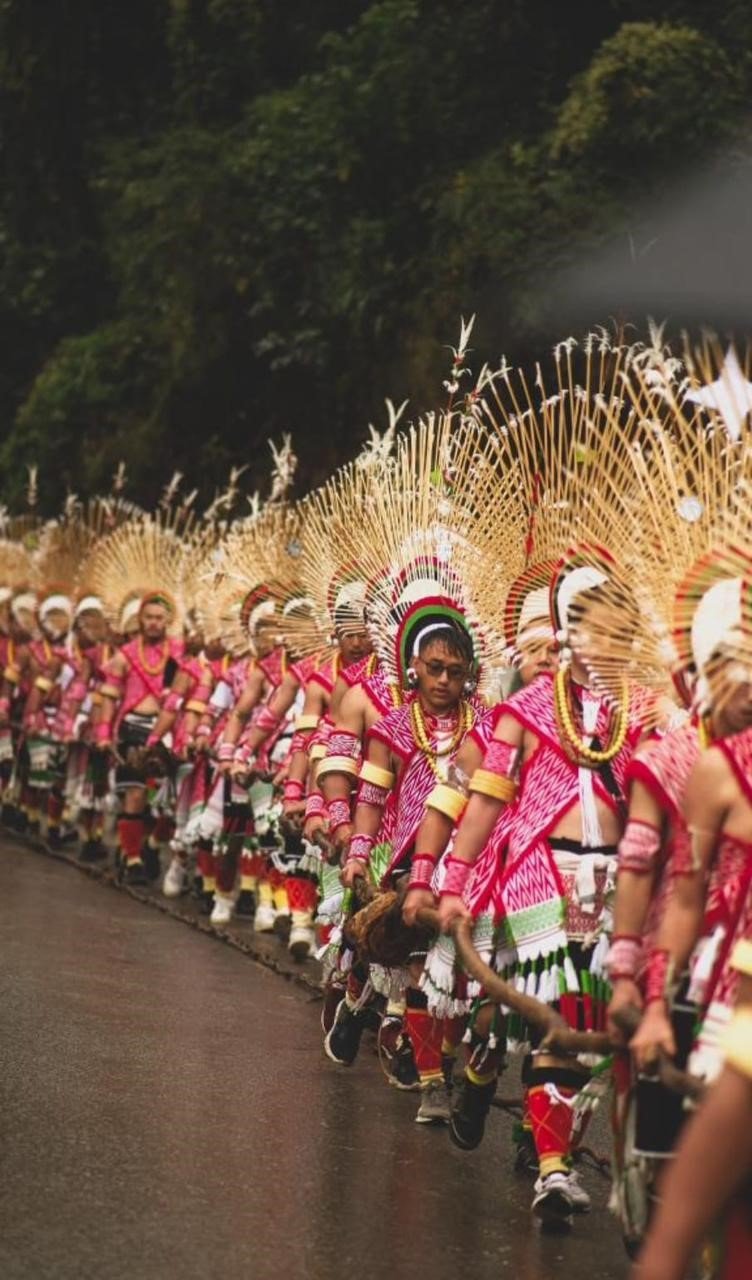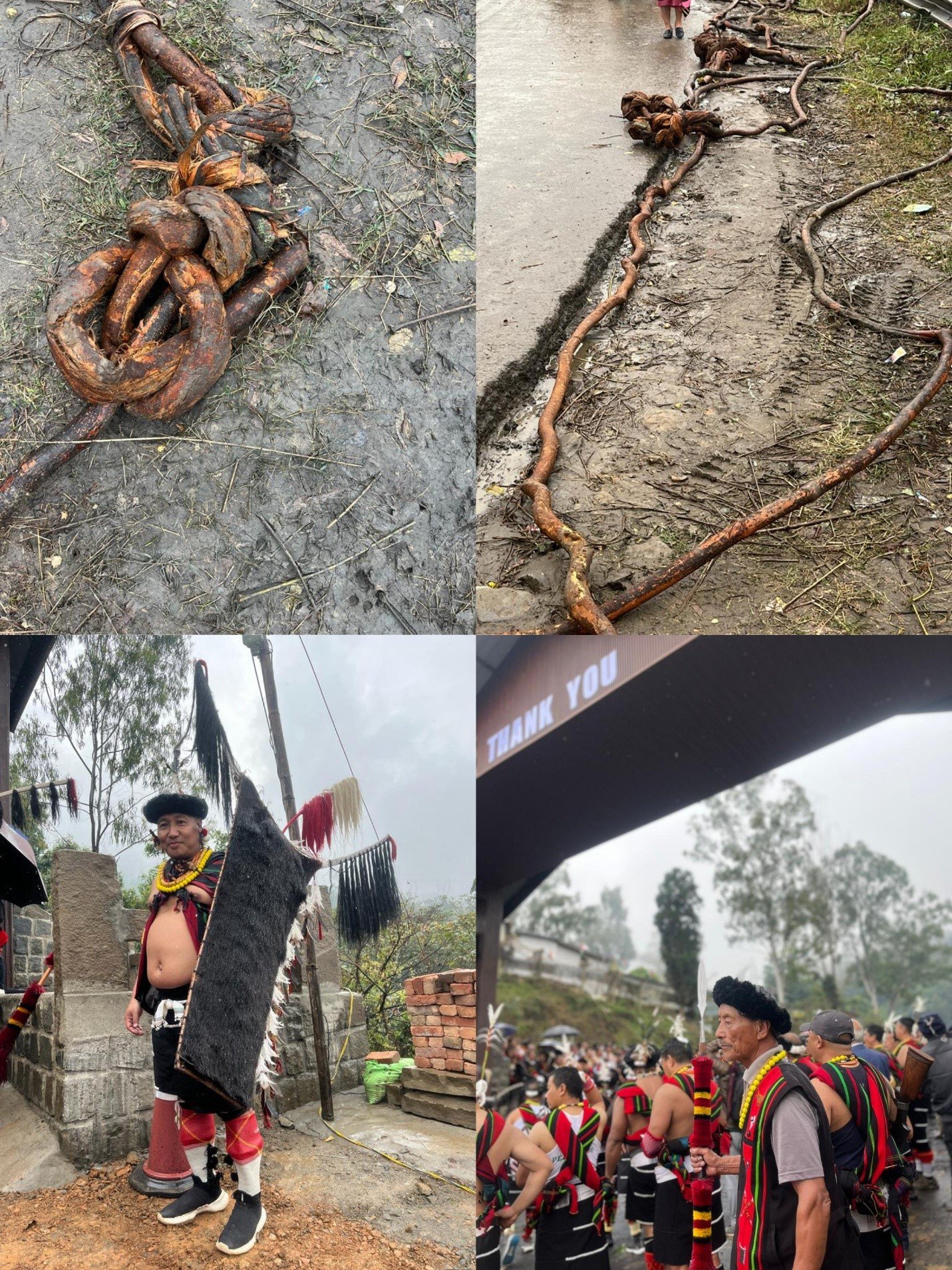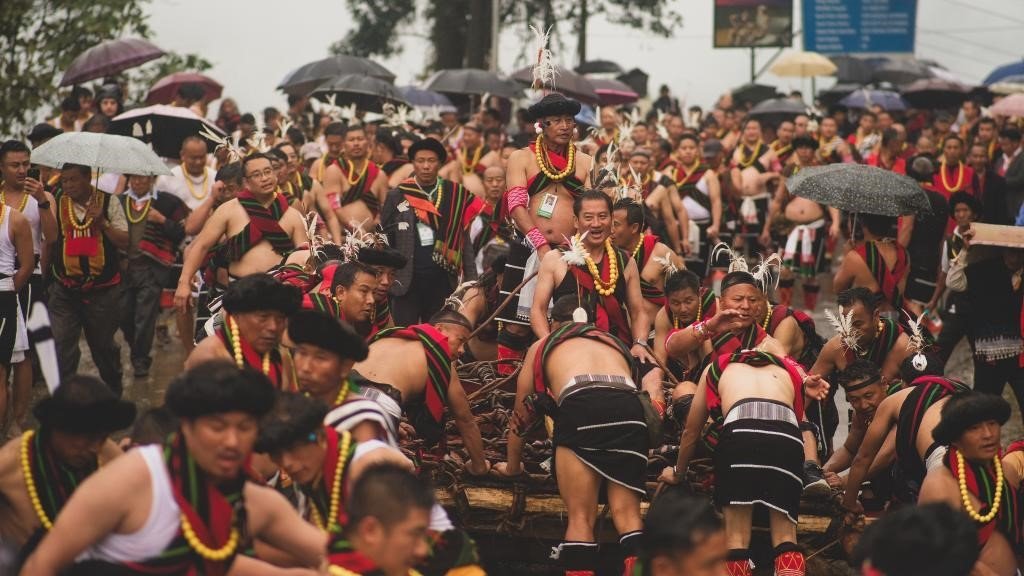According to ancestral Naga beliefs, the presence of rain during significant events is a symbol of good fortune or divine blessing. And among the Kewhimias (members of Kohima Village), every time the Tsütuonuomia Thinuo (T.Khel) Kharu is opened, it rains, and this phenomenon is perceived as a divine blessing.
Serendipitously, the State capital witnessed its winter rain today, as thousands braved the chilly winter rain, and extended solidarity during the Tsütuo Kharu (Gate) pulling ceremony of Tsütuonuomia Thinuo (T.Khel). The gathering dressed in their traditional attire, pulled the stone from Merhülietsa to Seithogei, covering a distance of nearly 4 km.

43 villages extended solidarity to the Tsütuonuomia Thinuo by taking part in the gate-pulling event, showcasing their unity, and cooperation. The event was also honored by the presence of legislators and other dignitaries.
Ambassador Javier Paulinich of the Republic of Peru to India graced the occasion as the ceremony’s Chief Guest while the event was hosted by the Chief Minister of Nagaland, Neiphiu Rio, with Tourism Minister Temjen Imna Along serving as the co-host.

The ceremony began with Neiphiu Rio greeting the ceremony where he expressed gratitude to the T.khel for granting him the opportunity to serve as the Chief Host, and also conveyed appreciation to the Thinuo on behalf of the government for orchestrating such events during the hornbill festival which showcases our rich culture, traditions, and practices to the tourists.
Rio highlighted the importance of initiatives like this event during the festive season, despite the challenges, further emphasizing the significance of the gate as a symbol of welcome for all who enter or pass through it. The abundance of joyous celebrations during the hornbill festival was acknowledged, and Rio conveyed the government’s deep appreciation for the efforts that bring pride and visibility to Nagaland.
“While the population is predominantly Christian, there is value in remembering our ancestral practices,” said Rio who also mentioned that during the British colonial era, the Naga culture and traditions were preserved. Notably, the British Parliament passed a law in 1873 protecting the peace, culture, and traditions of the Naga people.

The event was followed by the Mepfü (war cry) heralding the gate pulling ceremony, where the Chief Minister unveiled the unity stones of the 16 districts of Nagaland while the prayer was pronounced by Pastor Atuo Whourie.

Javier Paulinich, in his speech highlighted the profound connections that exist between the two nations of Peru and India. “This year marks the 60th anniversary of diplomatic relations between our countries, a proof of the friendship that has flourished over the decades. This reflects the shared values of diversity, unity, and mutual respect that bind our nations together,” he stated .
In recent years, both countries have engaged in robust economic partnerships, exploring avenues of collaboration in trade, technology, and innovation. India’s vibrant information technology sector and Peru’s growing industries present unique opportunities for mutually beneficial exchanges, laying the foundation for a dynamic economic relationship, highlighted the Ambassador.
“But beyond the diplomatic and economic ties, Peru and India also have in common the rich tapestry of our ancient cultures. It is fascinating to draw parallels between the ancient civilizations of our countries,” said Paulinich. He stated that the Caral-Supe civilization in Peru, known as the oldest civilization in the Americas, and the Indus Valley Civilization in India, one of the world’s oldest urban cultures, stand as testaments of the wisdom of our ancestors.

“As we know, both civilizations flourished around the same period, 5000 years ago, engaging in advanced urban planning, sophisticated agricultural practices, and intricate social systems,” reminded the Ambassador, who encouraged the gathering to recognize the enduring legacy of the two nations and to foster a deeper appreciation for the cultural ties that bind Peru and India, one that has withstood the test of time.
“Nagaland has become an example thanks to its efforts on cultural preservation and the commitment to promote the Naga traditions, exemplified by events like the Hornbill Festival, resonates deeply with us. It is a reminder that, despite the geographical distance, our cultural bonds are unbreakable, and events like these serve as bridges that connect countries,” asserted the Peruvian Ambassador.
He also acknowledged the Chief Minister Neiphiu Rio for extending this gracious invitation to Peru, stating that this strengthen the relations between Peru and India.

Highlighting the significance of Kharu in Naga society, Neibou Sekhose, Chairman of the T. Khel Council, noted that nearly every village in the region had its own boundary and gate. These village gates are constructed along pathways used by villagers to access their fields or travel outside their villages. The Tsütuo Kharu will be placed at Seithogei (NH-29) as a welcoming gate to Kohima, the capital of Nagaland. Alongside the gate, Sekhose mentioned, there are sixteen monument stones erected called the ‘Unity Stones’, symbolizing the unity of the sixteen districts of Nagaland.
Download Nagaland Tribune app on Google Play

“43 villages joined hands today with the aim of making this gate as a symbol of welcome for the Capital. The installation of this gate will communicate a message of unity and resilience to the community. The 16 unity stones will represent the harmony among all districts and the bond of affection they share,” stated Sekhose. Considerable amount of resources were dedicated to orchestrating the event, according to Sekhose who noted that the investment had proven to be worthwhile, as people from diverse locations had gathered and taken part, demonstrating their support and affection.

“The erection of this gate will stand as a symbol of divine protection against any adversities and will serve as a heartening sight for all,” asserted Sekhose.
Kohima Village now takes pride in a total of 16 Kharus, with five in Lhisemia Khel, three in Dapfütsumia Khel, three in Pfuchatshumia, and four in Tsütuonuomia.
Another significance of the event was the attendance of the Gorkha community, where Sekhose reminded that their alliance traces back to the 18th century, when Nepalese individuals migrated from Nepal, settled in Chandmari Kohima, and tended to their cattle. Consequently, the T.khel community embraced them as part of their own.
All the participants were treated to the signature Angami meat delicacy “Muodi” as part of the celebration.

